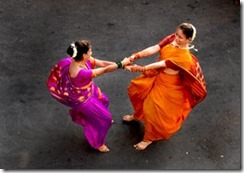 This is a group dance for women, with two major variations: as danced in a circle or by a rows of dancers. Broadly, villages have a dance in a circle but forest settlements have it in rows. A few fixed steps and hand gestures and hand laps are the elements.
This is a group dance for women, with two major variations: as danced in a circle or by a rows of dancers. Broadly, villages have a dance in a circle but forest settlements have it in rows. A few fixed steps and hand gestures and hand laps are the elements.
No instrument or musical accompaniment is found with the dance, but special fugdi songs are innumerable. The songs might be about Puranic stories, family life, complaints, rivalries or people.
Fugdis of different types are danced by women at such festival as the Dhalo or Ganesh Chaturthi - that is at both strictly at religious and folk celebrations.
A striking variation is the kalashi fugdi before Goddess Mahalakshmi during the vrata (disciplinary observance vowed to some diety) offered to that goddess. This is accompained by no songs, but the dancers carry the large vessels called kalashi or ghagar and blow into them rhythmically as they spin around.
A distinctive style of fugdi is found among the Dhangar (shepherd community) women. No songs go with it; two women join crossed hands and spin around together, bending and swaying to a distinct rhythm. Stylewise there is no clapping nor there are any special steps only the sway of the bodies is distinctive.
If you like this please Link Back to this article...


















